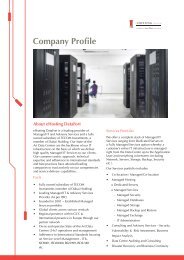Connecting with Cloud by eHDF
a valuable heated debate by eHDF
a valuable heated debate by eHDF
You also want an ePaper? Increase the reach of your titles
YUMPU automatically turns print PDFs into web optimized ePapers that Google loves.
CLOUD COMPUTING<br />
“THERE IS NO ACTUAL DATA [ON PRIVATE CLOUD UPTAKE] EXCEPT<br />
CLAIMS BY VENDORS THAT THEY HAVE SOLD CLOUD SOLUTIONS<br />
INTO THE REGIONAL MARKET. THESE ARE MOSTLY INSTANCES OF<br />
ON-PREMISE IMPLEMENTATIONS OF VIRTUALISED ENVIRONMENTS.”<br />
suite, the Oracle JD EnterpriseOne, which being a Tier-1 application<br />
required a competent technology delivery platform.”<br />
“EFS was looking to migrate to a model where investment was<br />
required only in core infrastructure, while the rest was shifted to a<br />
lease model. This strategy was essential as it allowed EFS to focus<br />
on future investments in people, processes and applications. In the<br />
project, one of the most important elements EFS benefited from<br />
was the service provider’s strategy to deploy a qualified team for<br />
the project. EFS was able to consolidate infrastructure, integrate<br />
all disparate systems and create a centralised infrastructure model<br />
that embraces service oriented architecture, coupled <strong>with</strong> governance<br />
models and industry best practices, all encapsulated into a<br />
new high availability data centre to ensure business continuity of<br />
information technology,” Abraham continues.<br />
“In addition EFS has seen benefits including standardised<br />
business processes, data loss prevention, organisational wide<br />
BENEFITS OF CLOUD<br />
A survey of 700 IT professionals conducted <strong>by</strong> Toluna and Qumu identified the<br />
following benefits of cloud computing:<br />
25%<br />
20%<br />
15%<br />
10%<br />
5%<br />
SECURITY<br />
COST SAV-<br />
INGS ONCE<br />
DEPLOYED<br />
BETTER<br />
MOBILITY<br />
SUPPORT<br />
TIME SAVED<br />
NOT HAVING<br />
TO UPDATE<br />
QUICK<br />
DEPLOY-<br />
MENT<br />
BETTER<br />
FOR ENVI-<br />
RONMENT<br />
ELASTICITY<br />
TO SCALE UP<br />
OR DOWN<br />
OUT-<br />
SOURCED<br />
SUPPORT<br />
security, pro-activeness to client requirements and agile solutions,<br />
meeting SLA and compliance requirements, and automated<br />
backup to ensure data resiliency and redundancy.”<br />
Clearly a private cloud solution offers many benefits. It provides<br />
organisations <strong>with</strong> greater control and security, and at the<br />
same time gives them the required agility to manage changing<br />
business needs.<br />
“Benefits Dell customers have seen include faster deployment,<br />
reduced risk and lower cost of ownership,” notes Harris.<br />
A private cloud solution also allows departments <strong>with</strong>in an<br />
organisation or a group company in a conglomerate to provision<br />
IT computing as a self-service and charge for actual consumption.<br />
Here, the IT department managing the infrastructure realises<br />
benefits as well, including those of standardisation, governance<br />
and productivity.<br />
“From an infrastructure perspective, private cloud is transforming<br />
dedicated and segregated IT computing power in an<br />
organisation into a standardised and shared pool of IT computing<br />
resources. This transformation is helping to create more efficient<br />
and effective utilisation practices,” notes Rao. “It also increases<br />
flexibility, allowing IT teams to cater to dynamic, new workloads.<br />
Additionally, the benefits are coming from quick deployment of<br />
the underlying IT infrastructure at a fraction of the cost.”<br />
Although benefits to private cloud adoption are clear, vendors<br />
are continuing to work on the introduction of new technologies to<br />
enhance the performance, security and manageability of private<br />
cloud. They’re also offering different solutions to suit different<br />
customer needs. For example, many are now offering more flexibility<br />
in creating an infrastructure to exceed the cost effectively<br />
of a virtualised infrastructure through higher workload density<br />
and greater resource utilisation. Then there’s the introduction of<br />
hourly metering and charging of the resources, which helps users<br />
to pay only for the duration of the usage.<br />
“Vendors are now focusing on delivering customised solutions<br />
where the key differentiator is the continued abstraction of computing<br />
resources from infrastructure and the machines (virtual<br />
or otherwise) used to deliver those resources. Only <strong>by</strong> delivering<br />
this abstraction can customers achieve the benefits of private<br />
cloud — including improved agility and responsiveness, reduced<br />
total cost of ownership, and increased business alignment and<br />
focus,” Kaul concludes.<br />
62 ARABIAN COMPUTER NEWS May 2013





